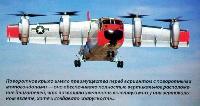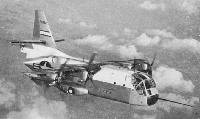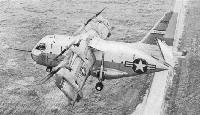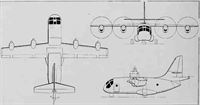
Описание
Страна : США
Год : 1964
Конвертоплан
Тактический военно-транспортный самолет с поворотным крылом и экипажем из двух-трех человек
Ling-Temco-Vought XC-142
Ling-Temco-Vought XC-142 рассматривался в качестве прототипа тактического военно-транспортного самолета, при создании которого использовались наработки, полученные в рамках реализации проекта X-18. Аппарат сохранил поворотное крыло, но в данном случае силовая установка включала четыре установленных на крыле двигателя, а продольное управление самолетом на режиме висения и переходных режимах осуществлялось при помощи размещенного на хвостовой балке в горизонтальной плоскости трехлопастного рулевого винта изменяемого шага. Фюзеляж прямоугольного сечения и трехопорное шасси явно свидетельствовали о транспортной роли машины.
Работы по проекту финансировали сразу три вида ВС США, первый полет аппарат совершил в сентябре 1964 года - в самолетном режиме. Пять опытных самолетов активно участвовали в программе летных испытаний, но в серию летательный аппарат не пошел - даже принимая во внимание тот факт, что при установке мощных двигателей T64-GE-S4A (мощностью по 3400 л. с.) можно было достичь максимальной взлетной массы 21 274 кг.
ТАКТИКО-ТЕХНИЧЕСКИЕ ХАРАКТЕРИСТИКИ
LTV XC-142A
Тип: тактический военно-транспортный самолет с поворотным крылом и экипажем из двух-трех человек
Силовая установка: четыре ГТД General Electric T64-GE-1 мощностью по 2850 л. с. (2125 кВт)
Летные характеристики: максимальная скорость на высоте 6096 м - 692 км/ч; практическая дальность с грузом, позволяющим выполнить вертикальный взлет, - 740 км, либо 1110 км - при коротком взлете
Масса: максимальная взлетная 16998 кг
Размеры: размах крыла 20,57 м; длина 17,71 м
- Описание
Фотографии
-
Мировая Авиация 172
XC-142 стал одним из первых успешных вариантов конвертоплана - он был разработан по заказу трех видов ВС США и мог брать на борт 32 военнослужащих или 3628 кг груза, но в серию не пошел.
-
Мировая Авиация 172
Поворотное крыло имело преимущества перед вариантом с поворотными мотогондолами - оно обеспечивало полностью вертикальное расположение двигателей, что позволяло увеличить взлетную массу при вертикальном взлете, хотя и создавало "парусность".
-
Aeroplane Monthly 1976-10 / A.Schoeni - Tilt-wing transport
An XC-142A with Stuart Madison at the controls, hovering over the Vought runway before a roadside audience.
-
Мировая Авиация 172
После провала попытки получить заказы на XC-142 от военных самолет был передан НАСА, где и эксплуатировался в 1966-1970 годах. Но идея поворотного крыла пока не забыта.
-
Aeroplane Monthly 1976-10 / A.Schoeni - Tilt-wing transport
25925 making a Stol take-off from the USS Bennington in 1966.
-
Jane's All the World Aircraft 1980 / Encyclopedia of Aviation - Aircraft A-Z - v4
LTV-Hiller-Ryan XC-142A.
-
OS 1 / H.Cowin - X-Planes
An 'in Country' photograph of 62.5925, the last of the five LTV-Hiller-Ryan XC-142As built, showing its ability to operate in and out of a desert strip during May 1965 trials in the Mojave area. The XC-142A was powered by four 3,080eshp General Electric T64-GE-I turboprops. The XC-142A spurned the puffer jet control of the Hiller X-18 in favour of using the differential propeller thrust management approach, the one problem with this was that it required the small, tail-mounted propeller, just visible under the slab tailplane, to maintain pitch axis control. It was the failure of this propeller that led to the one flight test fatal crash on 10 May 1967, killing the three LTV pilots. Stuart G. Madison., John Ornvig and Charles Jester. Capable of accommodating two pilots and 32 fully equipped troops, the XC-142A's top level speed was 431 mph at 20,000 feet, at which height it cruised at 253mph. The machine's tactical radius of action with full load ranged from 230 to 470 miles, depending on whether the departure and arrival were vertical or conventional. First flown from a rolling take-off on 26 September 1964, the first hover took place late in December, followed by the first full transitional flight on 11 January 1965. The five XC-l42As amassed 420 flying hours during 488 flights, the aircraft being handled by no less than 39 military and civilian pilots during the 1964 to 1967 period. Arguably, the XC-142A came very close to providing the world with its first effective VTOL transport. The aircraft had problems, but its biggest was undoubtedly its timing: its arrival coincided with the height of American involvement in South East Asia and the military clearly had more pressing calls upon its allotted funds.
-
Air Pictorial 1964-09
The LTV-Hiller-Ryan XC-142A V/STOL transport during tilt-wing trials
-
Aeroplane Monthly 1976-10 / A.Schoeni - Tilt-wing transport
The first flight of an XC-142A, made by 25922 on September 29, 1964.
-
Aeroplane Monthly 1977-07 / A.Schoeni - Sixty years of Vought
One of five of its kind, XC-142A tilt-wing transport 25924 is seen during conversion at the 1967 Paris Air Show.
-
Aeroplane Monthly 1976-10 / A.Schoeni - Tilt-wing transport
25924 in the blue and white livery applied for the 1967 Paris Air Show.
-
Jane's All the World Aircraft 1966 / 02 - Aircraft
LTV-Hiller-Ryan XC-142A in cruising flight with wing tilted fully down
-
Aeroplane Monthly 1976-10 / A.Schoeni - Tilt-wing transport
Although 25921 was the No 1 aircraft, it was not the first to fly, this honour falling to the second machine. No 1 crashed on May 10, 1967, killing its crew.
-
Aeroplane Monthly 1976-10 / A.Schoeni - Tilt-wing transport
The third XC-142A, 25923, hovers nose to nose with another in front of the Vought control tower, Dallas. This aircraft was damaged in a hard landing at Edwards AFB on January 3, 1966.
-
Aeroplane Monthly 1976-10 / A.Schoeni - Tilt-wing transport
A view of the first aircraft during transition, showing horizontal tail propeller.
-
Aeroplane Monthly 1976-10 / A.Schoeni - Tilt-wing transport
25921 over swampy terrain at Mountain Creek Lake prior to a Stol landing at the Vought plant.
-
Jane's All the World Aircraft 1966 / 02 - Aircraft
LTV-Hiller-Ryan XC-142A VTOL transport with wings in intermediate position
-
Aeroplane Monthly 1976-10 / A.Schoeni - Tilt-wing transport
Hovering nearly vertically, an XC-142A "rescues” a dummy from a lake near the Vought factory at Dallas, prior to making live rescues to test the aircraft’s capabilities in the air/sea rescue role.
-
Aeroplane Monthly 1976-10 / A.Schoeni - Tilt-wing transport
Another dummy rescue, showing the capacious fuselage and rear loading doors to advantage.
-
Aeroplane Monthly 1976-10 / A.Schoeni - Tilt-wing transport
25924, with its wing at 35°, unloads four 1,000lb pallets over the runway at the Naval Aerospace Recovery Facility, El Centro, California.
-
Aeroplane Monthly 1976-10 / A.Schoeni - Tilt-wing transport
25924 earlier in its life, dropping a cargo container over the El Centro parachute test range. John Omvig was the pilot.
-
Aeroplane Monthly 1976-10 / A.Schoeni - Tilt-wing transport
With its self-made dust storm in train, the No 1 XC-142A makes a Stol landing on a concrete runway. Note the extensive trailing edge flappery and leading edge slots.
-
Aeroplane Monthly 1976-10 / A.Schoeni - Tilt-wing transport
25925 touching down in a Stol landing aboard the USS Bennington. Lt Rich USN, and Maj Larsen USMC, made 44 take-offs and landings during these trials, both in the Stol and Vtol mode, proving the aircraft’s carrier potential.
-
Aeroplane Monthly 1976-10 / A.Schoeni - Tilt-wing transport
An engineer in Vought's low-speed wind tunnel contemplates a model which suffered wing failure during test.
-
Jane's All the World Aircraft 1964 / 01 - Aircraft
Chance Vought-Hiller-Ryan XC-142A tilt-wing transport
- Фотографии
























